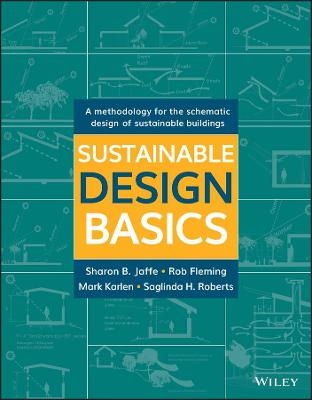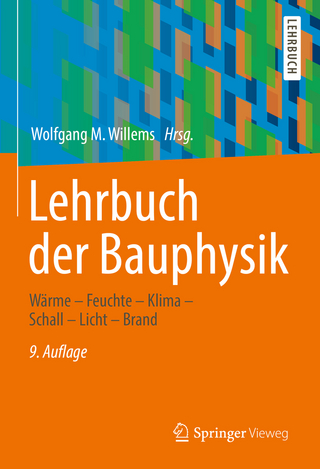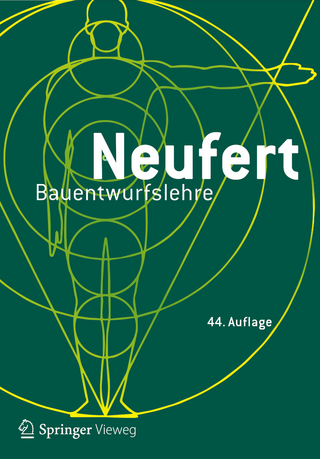
Sustainable Design Basics
John Wiley & Sons Inc (Verlag)
978-1-119-44373-5 (ISBN)
- Lieferbar (Termin unbekannt)
- Versandkostenfrei innerhalb Deutschlands
- Auch auf Rechnung
- Verfügbarkeit in der Filiale vor Ort prüfen
- Artikel merken
Sustainable Design Basics is a student-friendly introduction to a holistic and integral view of sustainable design. Comprehensive in scope, this textbook presents basic technical information, sustainability strategies, and a practical, step-by-step approach for sustainable building projects. Clear and relatable chapters illustrate how to identify the factors that reduce energy use, solve specific sustainable design problems, develop holistic design solutions, and address the social and cultural aspects of sustainable design. Requiring no prior knowledge of the subject, the text’s easy-to-follow methodology leads readers through the fundamental sustainable design principles for the built environment.
Sustainably-constructed and maintained buildings protect the health and improve the productivity of their occupants, as well as help to restore the global ecosystem. The authors, leading practitioners and educators in sustainable design, have created a resource that provides a solid introduction to broad level sustainability thinking that students can take forward into their professional practice. Topics include space planning for sustainable design, integrative and collaborative design, standards and rating systems, real-world strategies to conserve energy and resources through leveraging renewable natural resources and innovative construction techniques and their impact on our environment.
Usable and useful both in and beyond the classroom, this book:
Covers building location strategies, building envelopes and structures, integration of passive and active systems, green materials, and project presentation
Examines cultural factors, social equity, ecological systems, and aesthetics
Provides diverse student exercises that vary by climate, geography, setting, perspective, and typology
Features a companion website containing extensive instructor resources
Sustainable Design Basics is an important resource aimed at undergraduate architecture and interior design students, or first-year graduate students, as well as design professionals wishing to integrate sustainable design knowledge and techniques into their practice.
Sharon B. Jaffe, LEED AP ID + C, IIDA, NCIDQ is a designer, educator, sustainable redeveloper, and community activist, specializing in the collaborative development of sustainable environments. She currently teaches at Thomas Jefferson University in Philadelphia, PA. Rob Fleming, AIA, LEED AP has been teaching, researching, advocating, and practicing sustainable design for over 20 years. He is the founding director of, and a professor in, the MS in Sustainable Design Program at Thomas Jefferson University in Philadelphia, PA. Mark Karlen, Ph.D., AIA, NCIDQ has been practicing, teaching, and writing about interior design and architecture for several decades. He has chaired interior architecture programs at the University of Cincinnati and Pratt Institute. Saglinda H. Roberts, IIDA, CID, LEED Green Associate has over 30 years of extensive design experience; her focused research is on the future of restorative and holistic sustainable design. She currently teaches in the Interior Architecture program at Chatham University.
Acknowledgments xiii
About the Authors xv
About the Companion Website xvii
Chapter 1 Why, How, Who, and What 1
Why Use This Book 1
How to Use This Book 2
Who Should Use This Book 2
What are the Parameters of This Book 2
Organization 3
Exercises 3
Companion Website 3
Chapter 2 Mindset 5
The Holocene and the Age of Agriculture 6
The Industrial Revolution and the Environment 6
Environmentalism and the Age of Information 7
Realizations of the Historic Sustainability Events Timeline 11
Thinking and Seeing from Multiple Perspectives 13
Integral Sustainable Design 13
The Four Perspectives of Integral Sustainable Design 14
Learning from the Past: General Rules 16
Space and Scale 17
The Integrative Design Process 18
Chapter 3 Step 1: Context 21
The Sustainable Design Basics Methodology: An Overview 21
Step 1: Context 23
Step 1A: Project Information 24
Step 1B: Guiding Principles 26
Step 1C: Macro Context and Micro Context 28
Step 1D: Site Inventory and Analysis 35
Chapter 4 Step 2 Pre-Planning 55
Research and Organization 55
Step 2A: Case Study 56
Step 2B: Project Goals 63
Step 2C: Criteria Matrix 67
Step 2D: Relationship Diagrams 73
Chapter 5 Step 3: Design 77
Whole Building Thinking, Systems Thinking 77
3A Preliminary Design 80
Chapter 6 Step 3B: Passive Design 117
What is Passive Design? 117
Key Elements of Passive Design 118
Passive Design Strategies 122
Passive Solar Heating 126
Passive Cooling and Natural Ventilation 134
Water Conservation and Rainwater Harvesting 152
Passive Design Validation 157
Chapter 7 Step 3B: Passive Design, Daylighting 159
Daylighting 159
Chapter 8 Step 3C: Building Envelope 187
What is the Building Envelope? 187
Functions 188
The Building Envelope in the SDB Methodology 189
Building Envelope and Macroclimate 190
Building Structure and the Building Envelope 192
Building Foundations 198
Exterior Wall Assembly 202
Windows 210
Roof Systems 217
Validation, Synergies, and Synthesis of Design 226
Chapter 9 Step 3D: Green Materials 229
Basics 229
Evaluation 236
Overarching Objectives 245
Material and Product Resources 248
A Warning about Greenwashing 248
Chapter 10 Step 4: Design Resolution 251
Step 4A: Final Design Synthesis 252
Step 4B: Final Design Validation 253
Step 4C: Presenting the Project 261
Chapter 11 Demonstration Project 265
Step 1: Context 266
Step 2: Pre-Planning 278
Step 3: Design 286
Chapter 12 Beyond the Basics 323
Active Systems 324
PV Array Sizing and Net-Zero Energy 326
Chapter 13 Design Resolution 335
Final Design Synthesis 335
Final Validation 341
Conclusion 349
Chapter 14 Demonstration Project: Final Presentation 351
Step 1: Project Introduction and Context 352
Step 2: Pre-Planning 354
Conclusion 361
Chapter 15 Exercises 363
Sustainable Building Design Exercises 363
Choice 1: Client Details 365
Choice 2: Site Selection and Macro Climate 370
Choice 3: Macro Context Details 371
Choice 4: New Building or Existing Building 372
Exercises 373
Appendix A: Demonstration Project Program, Climate, and Context Resources 375
Step 1A: Project Introduction 375
Step 1C Macro and Micro Context 378
Step 1D Site Inventory and Analysis 382
Appendix B: Forms and Matrices 387
Appendix C: Energy Modeling Software 419
Notes about Energy and Daylighting Simulation 419
SEFAIRA 421
Rhino Architectural Software 421
Open Studio 422
IES (Integrated Environmental Solutions) 423
Equest 424
Revit Green Building Studio by AutoDesk 425
Appendix D: Abbreviations and Acronyms 427
Appendix E: Green Building Standards, Codes and Rating Systems 431
The Role of Codes and Standards 431
The Role of Rating Systems 431
Green Building Standards, Codes and Rating Systems 431
Bibliography 441
Index 449
| Erscheinungsdatum | 14.04.2020 |
|---|---|
| Verlagsort | New York |
| Sprache | englisch |
| Maße | 213 x 274 mm |
| Gewicht | 1338 g |
| Themenwelt | Technik ► Architektur |
| ISBN-10 | 1-119-44373-3 / 1119443733 |
| ISBN-13 | 978-1-119-44373-5 / 9781119443735 |
| Zustand | Neuware |
| Haben Sie eine Frage zum Produkt? |
aus dem Bereich


